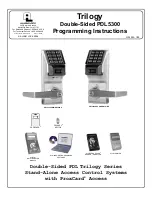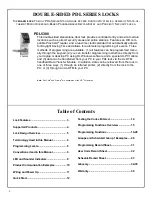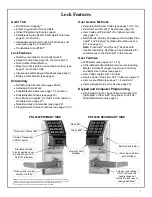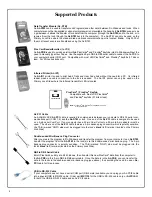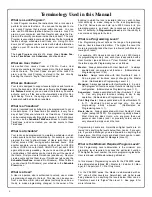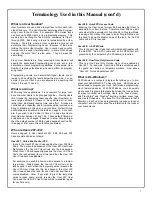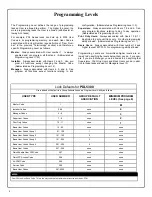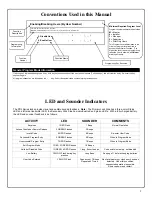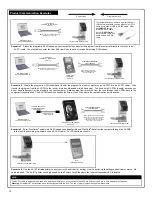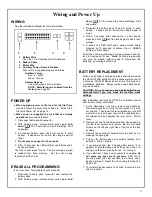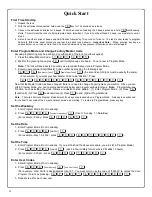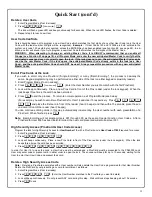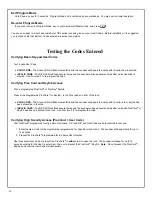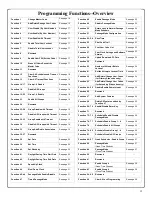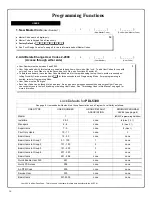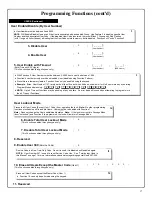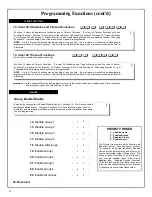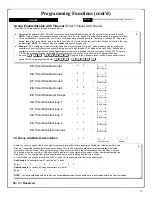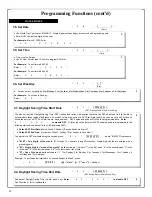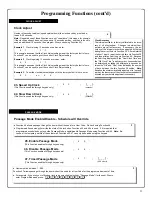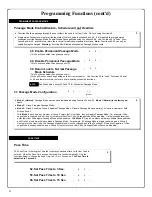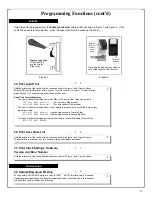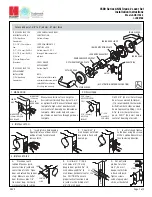
8
USER TYPE
USER NUMBER
GROUP DEFAULT
ASSOCIATION
MINIMUM PROGRAM
LEVEL (See page 6)
Master Code
1
-
M
Installer Codes
2 & 3
none
4
Manager Codes
4 - 6
none
3
Supervisor Codes
7 - 9
none
2
Print Only Codes
10 - 11
none
1
Basic User Codes
12 - 50
none
none
Basic User Codes Group 1
51 - 100
1
none
Basic User Codes Group 2
101 - 150
2
none
Basic User Codes Group 3
151 - 200
3
none
Basic User Codes Group 4
201 - 250
4
none
Basic User Codes
251 - 296
none
none
Quick Enable User 300 Code
297
none
none
Quick PC Access Code
298
none
none
AL-DTM Code
299
none
none
Service Code
300
none
none
Basic User Codes
301-2000
none
none
Lock Defaults for
PDL5300
Users added
will default to a Group Association and a Program Level Ability as follows:
User 299 is a Non-Pass Code. This is the only code that will initiate data transfer with the AL-DTM.
NOTES:
The Programming Level defines the range of programming
tasks a User is allowed to perform. The higher the Level, the
more programming tasks the User is allowed (with Master al-
lowing ALL tasks).
For example, PDL Series locks can hold up to 2000 User
Codes in its programming memory, and each User Code is
associated with a User Number (see definition of "User Num-
ber" in the previous "Terminology" section) and therefore a
specific Programming Level, as follows:
Master:
Always associated with User number 1. Is always
enabled and can program all functions. (Abbreviated as
Programming Level = M).
Installer:
Always associated with Users 2 and 3. Can pro-
gram all functions except changing the Master Code.
(Abbreviated as Programming Level = 4).
Manager:
Always associated with Users 4, 5, and 6. Can
program all functions except functions relating to lock
configuration. (Abbreviated as Programming Level = 3).
Supervisor:
Always associated with Users 7, 8 and 9. Can
only program functions relating to day to day operation.
(Abbreviated as Programming Level = 2).
Print Only Users:
Always associated with Users 10 & 11.
Restricted to print audit trails only. No other programming
ability allowed. (Abbreviated as Programming Level = 1).
Basic Users:
Always associated with User number 12 and
higher (except 297-300). No programming ability allowed.
Programming Levels are hierarchical--higher levels are al-
lowed to do anything the levels below them can do. For exam-
ple, if you are a
Manager
, you are allowed to do anything that
Supervisors
,
Print-Only Users
and
Basic Users
can do in addi-
tion to those tasks allowed for Managers (Level 3).
Programming Levels

